1. Chaikof EL, Dalman RL, Eskandari MK, Jackson BM, Lee WA, Mansour MA, et al. The Society for Vascular Surgery practice guidelines on the care of patients with an abdominal aortic aneurysm. J Vasc Surg. 2018; 67(1):2–77.e2. PMID:
29268916.

2. Howard DP, Banerjee A, Fairhead JF, Handa A, Silver LE, Rothwell PM, et al. Age-specific incidence, risk factors and outcome of acute abdominal aortic aneurysms in a defined population. Br J Surg. 2015; 102(8):907–915. PMID:
25955556.

3. Hynes N, Kok N, Manning B, Mahendran B, Sultan S. Abdominal aortic aneurysm repair in octogenarians versus younger patients in a tertiary referral center. Vascular. 2005; 13(5):275–285. PMID:
16288702.

4. Hicks CW, Obeid T, Arhuidese I, Qazi U, Malas MB. Abdominal aortic aneurysm repair in octogenarians is associated with higher mortality compared with nonoctogenarians. J Vasc Surg. 2016; 64(4):956–965.e1. PMID:
27364946.

5. Ambler GK, Gohel MS, Mitchell DC, Loftus IM, Boyle JR. Audit and Quality Improvement Committee of the Vascular Society of Great Britain and Ireland. The abdominal aortic aneurysm statistically corrected operative risk evaluation (AAA SCORE) for predicting mortality after open and endovascular interventions. J Vasc Surg. 2015; 61(1):35–43. PMID:
24985535.

6. Paolini D, Chahwan S, Wojnarowski D, Pigott JP, LaPorte F, Comerota AJ. Elective endovascular and open repair of abdominal aortic aneurysms in octogenarians. J Vasc Surg. 2008; 47(5):924–927. PMID:
18358669.

7. Ballotta E, Da Giau G, Bridda A, Gruppo M, Pauletto A, Martella B. Open abdominal aortic aneurysm repair in octogenarians before and after the adoption of endovascular grafting procedures. J Vasc Surg. 2008; 47(1):23–30. PMID:
18060731.

8. Thomson IA, Goh F, Livingstone V, van Rij AM. How safe is open abdominal aortic aneurysm surgery for octogenarians in New Zealand? ANZ J Surg. 2009; 79(5):344–347. PMID:
19566514.

9. Morisaki K, Matsumoto T, Matsubara Y, Inoue K, Aoyagi Y, Matsuda D, et al. Elective endovascular vs. open repair for abdominal aortic aneurysm in octogenarians. Vascular. 2016; 24(4):348–354. PMID:
26223528.

10. Lilja F, Mani K, Wanhainen A. Editor's choice - trend-break in abdominal aortic aneurysm repair with decreasing surgical workload. Eur J Vasc Endovasc Surg. 2017; 53(6):811–819. PMID:
28392057.

11. Blackstock CD, Jackson BM. Open surgical repair of abdominal aortic aneurysms maintains a pivotal role in the endovascular era. Semin Intervent Radiol. 2020; 37(4):346–355. PMID:
33041480.

12. Budtz-Lilly J, Venermo M, Debus S, Behrendt CA, Altreuther M, Beiles B, et al. Editor's choice - assessment of international outcomes of intact abdominal aortic aneurysm repair over 9 years. Eur J Vasc Endovasc Surg. 2017; 54(1):13–20. PMID:
28416191.

13. de Leur K, Flu HC, Ho GH, de Groot HG, Veen EJ, van der Laan L. Outcome of elective treatment of abdominal aortic aneurysm in elderly patients. Int J Surg. 2015; 15:117–123. PMID:
25659364.

14. Sonesson B, Björses K, Dias N, Rylance R, Mani K, Wanhainen A, et al. Outcome after ruptured AAA repair in octo- and nonagenarians in Sweden 1994–2014. Eur J Vasc Endovasc Surg. 2017; 53(5):656–662. PMID:
28356210.

15. Woo EY, Ullery BW, Carpenter JP, Wang GJ, Fairman RM, Jackson BM. Open abdominal aortic aneurysm repair is feasible and can be done with excellent results in octogenarians. J Vasc Surg. 2011; 53(2):278–284. PMID:
21030199.

16. Zettervall SL, Schermerhorn ML, Soden PA, McCallum JC, Shean KE, Deery SE, et al. The effect of surgeon and hospital volume on mortality after open and endovascular repair of abdominal aortic aneurysms. J Vasc Surg. 2017; 65(3):626–634. PMID:
27988158.

17. Dakour-Aridi H, Nejim B, Locham S, Alshwaily W, Malas MB. Anemia and postoperative outcomes after open and endovascular repair of intact abdominal aortic aneurysms. J Vasc Surg. 2019; 69(3):738–751.e2. PMID:
30685198.

18. Inagaki E, Farber A, Eslami MH, Kalish J, Rybin DV, Doros G, et al. Preoperative hypoalbuminemia is associated with poor clinical outcomes after open and endovascular abdominal aortic aneurysm repair. J Vasc Surg. 2017; 66(1):53–63.e1. PMID:
28216349.

19. Vemuri C, Wainess RM, Dimick JB, Cowan JA Jr, Henke PK, Stanley JC, et al. Effect of increasing patient age on complication rates following intact abdominal aortic aneurysm repair in the United States. J Surg Res. 2004; 118(1):26–31. PMID:
15093713.
20. Lounes Y, Chastant R, Gilbert M, Ozdemir BA, Alric P, Canaud L. Open abdominal aortic aneurysm repair is feasible in high risk and elderly patients unsuitable for standard EVAR. Eur J Vasc Endovasc Surg. 2019; 58(6):e600–e601.

21. Davenport DL, Xenos ES, Hosokawa P, Radford J, Henderson WG, Endean ED. The influence of body mass index obesity status on vascular surgery 30-day morbidity and mortality. J Vasc Surg. 2009; 49(1):140–147. 147.e1PMID:
19028047.

22. Raval MV, Eskandari MK. Outcomes of elective abdominal aortic aneurysm repair among the elderly: endovascular versus open repair. Surgery. 2012; 151(2):245–260. PMID:
21244863.

23. Abbruzzese TA, Kwolek CJ, Brewster DC, Chung TK, Kang J, Conrad MF, et al. Outcomes following endovascular abdominal aortic aneurysm repair (EVAR): an anatomic and device-specific analysis. J Vasc Surg. 2008; 48(1):19–28. PMID:
18440182.

24. Herman CR, Charbonneau P, Hongku K, Dubois L, Hossain S, Lee K, et al. Any nonadherence to instructions for use predicts graft-related adverse events in patients undergoing elective endovascular aneurysm repair. J Vasc Surg. 2018; 67(1):126–133. PMID:
28760581.

25. Park KH, Lim C, Lee JH, Yoo JS. Suitability of endovascular repair with current stent grafts for abdominal aortic aneurysm in Korean patients. J Korean Med Sci. 2011; 26(8):1047–1051. PMID:
21860555.

26. Bae T, Lee T, Jung IM, Ha J, Chung JK, Kim SJ. Limited feasibility in endovascular aneurysm repair using currently available graft in Korea. J Korean Med Sci. 2008; 23(4):651–656. PMID:
18756052.

27. Charbonneau P, Hongku K, Herman CR, Habib M, Girsowicz E, Doonan RJ, et al. Long-term survival after endovascular and open repair in patients with anatomy outside instructions for use criteria for endovascular aneurysm repair. J Vasc Surg. 2019; 70(6):1823–1830. PMID:
31126766.

28. Powell JT, Sweeting MJ, Ulug P, Blankensteijn JD, Lederle FA, Becquemin JP, et al. Meta-analysis of individual-patient data from EVAR-1, DREAM, OVER and ACE trials comparing outcomes of endovascular or open repair for abdominal aortic aneurysm over 5 years. Br J Surg. 2017; 104(3):166–178. PMID:
28160528.
29. Lederle FA, Kyriakides TC, Stroupe KT, Freischlag JA, Padberg FT Jr, Matsumura JS, et al. Open versus endovascular repair of abdominal aortic aneurysm. N Engl J Med. 2019; 380(22):2126–2135. PMID:
31141634.

30. Becquemin JP, Pillet JC, Lescalie F, Sapoval M, Goueffic Y, Lermusiaux P, et al. A randomized controlled trial of endovascular aneurysm repair versus open surgery for abdominal aortic aneurysms in low- to moderate-risk patients. J Vasc Surg. 2011; 53(5):1167–1173.e1. PMID:
21276681.

31. van Schaik TG, Yeung KK, Verhagen HJ, de Bruin JL, van Sambeek MRHM, Balm R, et al. Long-term survival and secondary procedures after open or endovascular repair of abdominal aortic aneurysms. J Vasc Surg. 2017; 66(5):1379–1389. PMID:
29061270.

32. Patel R, Sweeting MJ, Powell JT, Greenhalgh RM. EVAR trial investigators. Endovascular versus open repair of abdominal aortic aneurysm in 15-years' follow-up of the UK endovascular aneurysm repair trial 1 (EVAR trial 1): a randomised controlled trial. Lancet. 2016; 388(10058):2366–2374. PMID:
27743617.

33. Scallan O, Novick T, Power AH, DeRose G, Duncan A, Dubois L. Long-term outcomes comparing endovascular and open abdominal aortic aneurysm repair in octogenarians. J Vasc Surg. 2020; 71(4):1162–1168. PMID:
31519509.

34. Kansal V, Nagpal S, Jetty P. Editor's choice - late open surgical conversion after endovascular abdominal aortic aneurysm repair. Eur J Vasc Endovasc Surg. 2018; 55(2):163–169. PMID:
29223353.

35. Schanzer A, Greenberg RK, Hevelone N, Robinson WP, Eslami MH, Goldberg RJ, et al. Predictors of abdominal aortic aneurysm sac enlargement after endovascular repair. Circulation. 2011; 123(24):2848–2855. PMID:
21478500.

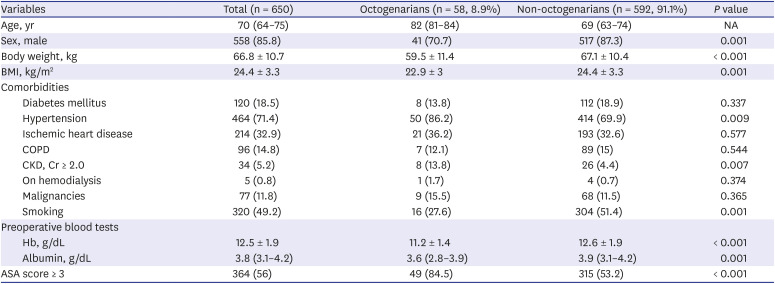
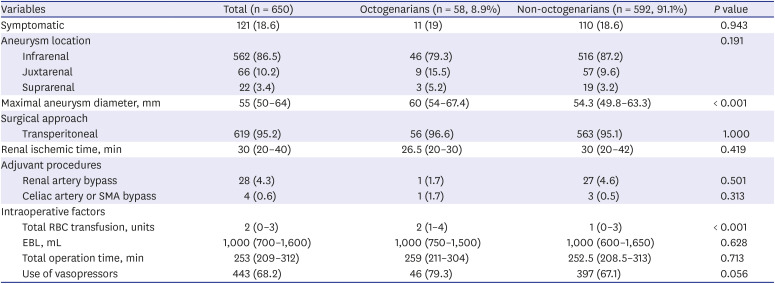
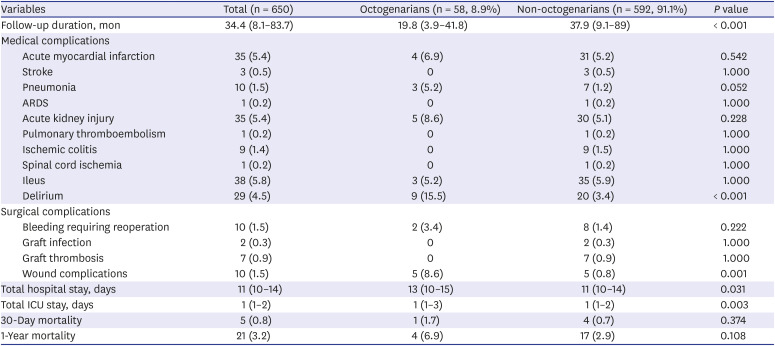
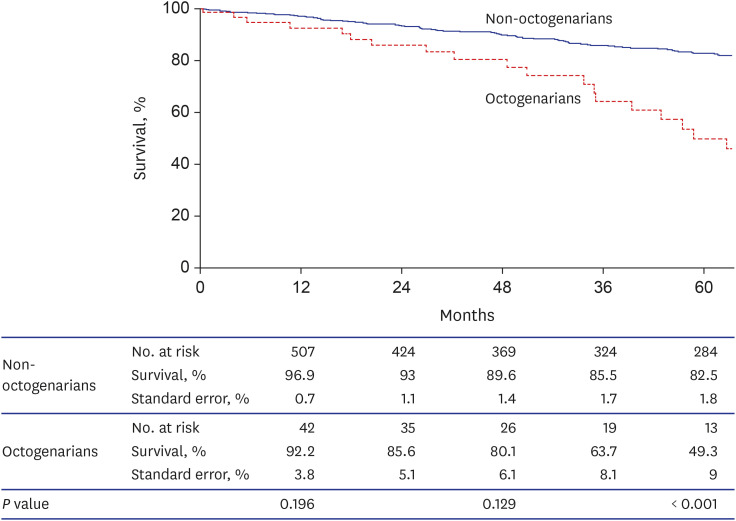





 PDF
PDF Citation
Citation Print
Print



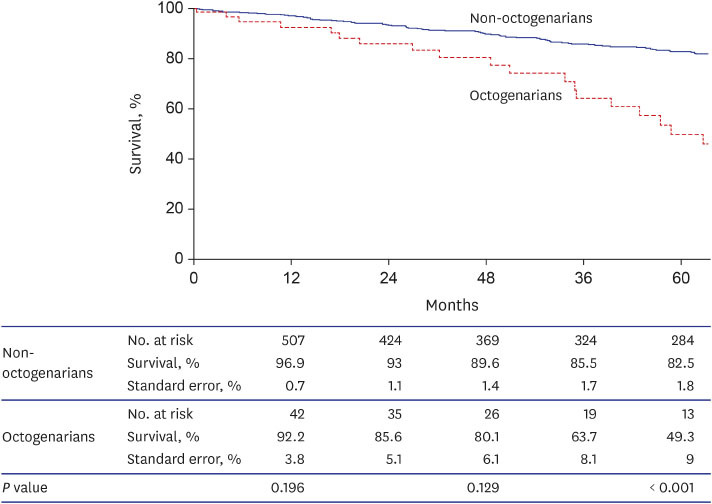
 XML Download
XML Download